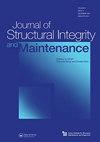Bond characteristics between concrete and near-surface mounted carbon fiber reinforced polymer cords
IF 3.1
Q2 ENGINEERING, CIVIL
Journal of Structural Integrity and Maintenance
Pub Date : 2021-10-02
DOI:10.1080/24705314.2021.1950379
引用次数: 6
Abstract
ABSTRACT Previous studies showed that near-surface mounting (NSM) strengthening technique with rigid CFRP materials has potential advantages over the externally bonded reinforcing (EBR), therefore, it becomes efficient methodology for concrete strengthening. However, rigid NSM-CFRP cannot be wrapped around a deteriorated structural element; the need for the existence of flexible material has appeared. Therefore, in this study the flexible NSM-CFRP (cord) is investigated as strengthening technique instead of rigid NSM-CFRP. The aim of this study is to recognize the parameters affecting the bond performance of carbon fiber-reinforced concrete (CFRP) cord and concrete. These parameters are cords’ bonded length, the ratio between cord’s width and depth, concrete compressive strength, number of CFRP cords used and the distance separating cords in multi-cord specimens. Fifty-four concrete prisms were cast from 25 MPa and 50 MPa concrete compressive strengths. Thirtyeight prisms reinforced by a single cord with various cord sizes were prepared. Twelve and four specimens were reinforced with two and three cords, respectively. In the case of multi-cord specimens, a unified bond length and cord’s aspect ratio were carried out. The main parameter to be studied in this case is the cords’ separating spacing. The test results indicated that increasing (NSMCFRP) cords bonded length, concrete compressive strength, number of applied CFRP cords, the spacing between cords and reducing cords’ aspect ratio (width/depth ratio) cause an increment in the pull-out force, and then a better strengthening is achieved. Rupture was the predominant failure mode for specimens with the same bond and equal cord dimension, while debonding of the CFRP cords is the most frequent failure mode for multi-cords specimens with greater spacing.混凝土和近表面安装碳纤维增强聚合物帘线之间的粘结特性
摘要先前的研究表明,刚性CFRP材料的近表面贴装加固技术比外粘结加固技术具有潜在的优势,因此,它成为混凝土加固的有效方法。然而,刚性NSM-CFRP不能包裹在退化的结构元件周围;已经出现了对柔性材料存在的需求。因此,在本研究中,柔性NSM-CFRP(帘线)代替刚性NSM-CFRF作为加固技术进行了研究。本研究的目的是识别影响碳纤维增强混凝土(CFRP)帘线与混凝土粘结性能的参数。这些参数包括帘线的粘结长度、帘线宽度与深度之比、混凝土抗压强度、使用的CFRP帘线数量以及多帘线试样中帘线的分离距离。采用25 MPa和50 MPa的混凝土抗压强度浇注54个混凝土棱柱。制备了由不同帘线尺寸的单根帘线增强的三十个棱镜。12个和4个试样分别用两根和三根绳索加固。在多帘线试样的情况下,进行了统一的粘结长度和帘线的纵横比。在这种情况下要研究的主要参数是帘线的分离间距。试验结果表明,增加(NSMCFRP)帘线的粘结长度、混凝土抗压强度、CFRP帘线的数量、帘线间距和降低帘线的纵横比(宽深比)会导致拔出力增加,从而获得更好的加固效果。对于具有相同粘结和相同帘线尺寸的试件,断裂是主要的失效模式,而对于具有较大间距的多帘线试件,CFRP帘线的脱胶是最常见的失效模式。
本文章由计算机程序翻译,如有差异,请以英文原文为准。
求助全文
约1分钟内获得全文
求助全文
来源期刊

Journal of Structural Integrity and Maintenance
ENGINEERING, CIVIL-
CiteScore
3.90
自引率
9.50%
发文量
24
 求助内容:
求助内容: 应助结果提醒方式:
应助结果提醒方式:


